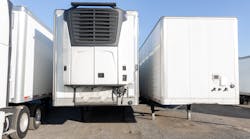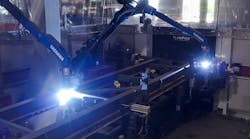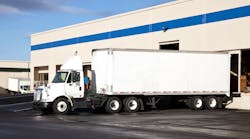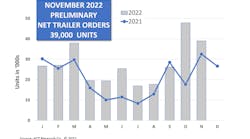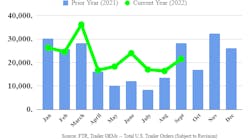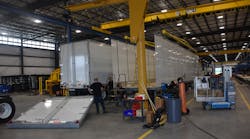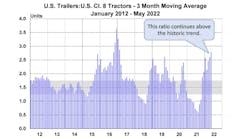THE 30 LARGEST MANUFACTURERS of truck trailers in North America increased their production by about 31% in 2004. The top 10 manufacturers increased output by 30.5%, limited partly because some of these manufacturers reached full plant capacity. The top three producers were up an average of 32%.
Using 230,000 as the total estimated production of new truck trailers in the United States in 2004, the top three manufacturers built 58% of the units, compared to about 54% the previous year.
This list of North American trailer manufacturers' output cannot be compared with the U S production total without subtracting out the two Canadian and two Mexican trailer manufacturers, as well as the rebuilt trailers. Subtracting out those 27,000 units leaves about 201,400 new truck trailers built in the United States in 2004 by 25 manufacturers. These 25 largest producers had about an 87.6% share of the U S market in 2004.
The same 10 companies were in the top 10 for both 2003 and 2004, but four of them changed rankings. The top 30 includes a few new entrants, such as Vanguard National, Reitnouer Inc, and Western Trailer.
This Trailer/Body Builders annual survey is made by telephoning a member of the management team at each trailer manufacturing company. It is built on the voluntary contribution of trailer production information at each company. An estimate is made for the two companies that chose not to participate. The survey is the work of Trailer/Body Builders and should not be confused with any other survey.
-
Great Dane Limited Partnership is estimated to be the largest manufacturer of truck trailers. Trailer/Body Builders estimates, based on the rate of increase of other large van trailer manufacturers, that Great Dane produced about 55,000 truck trailers in 2004.
-
Wabash National Corporation built 47,744 complete trailers in 2004, a 32% increase over 2003. Of these, 4,438 were refrigerated trailers, a 34% increase, and 43,306 were dry freight vans. Wabash also built 1,476 domestic containers, up 13%, and 874 container chassis, up 18%. The company also built 179 converter dollies for a grand total of 50,273 units.
“The industry is in the midst of a multi-year market upswing,” says CEO William Greubel. “We expect that 2005 will be another strong year in the trailer industry as carriers continue to replace and upgrade their trailer fleets over the next few years.
“The industry will continue to demand improved technology and component warranty with the focus on longer trailer life. In 2005 we will continue further reduction in the total cost of trailer ownership and work towards a 10-year maintenance-free trailer.
“The tenth year of the composite sidewall trailer will be in 2005. Wabash National will celebrate the production of a quarter million DuraPlate trailers. One out of every three dry freight trailers the industry produced in North America last year was manufactured with DuraPlate sidewalls. We expect this share to grow to over 50% in the next few years.”
-
Utility Trailer Manufacturing increased trailer production 30%, turning out 30,802 complete trailers in 2004. Utility also retained its position as the leading manufacturer of refrigerated trailers by turning out 29% more reefers. The final count was some 16,100 refrigerated vans.
At the same time, Utility continued to make inroads into the dry van sector with its new DX van, producing just under 12,000 vans, up 23%. Utility doubled its number of platforms and curtainsiders, with 2,867 produced.
Continuing into 2005, the trailer market is very strong, says Craig Bennett, executive vice-president, sales and marketing. “We have the highest backlog in two years, in excess of $350 million.” He expects the trailer industry to be up 10% in 2005.
-
Stoughton Trailers LLC in Stoughton, Wisconsin, built 50% more trailers in 2004 than the previous year. The trailer output included 14,650 van trailers and 200 flatbeds. Stoughton's intermodal business was about the same — 1,000 containers and 2,200 container chassis.
Stoughton's Z-Plate trailer led the increase in van trailers, increasing in popularity much faster than sheet-and-post vans. The Z-Plate is a composite plate sandwiching a polyethylene and cellulose core between two high-tensile steel skins.
The strong trailer market is continuing into 2005. However, Don Wahlin, Stoughton CEO, believes that it is not growing as fast as in 2004 and may be leveling off.
-
Hyundai Translead built 9,270 van trailers in 2004, a 4½% increase. Of these, 8,799 were dry freight vans and 471 were refrigerated, which is more than twice as many reefers as the previous year. Domestic container production was up 16% to 4,625 boxes. Container chassis production was up sharply. New chassis alone numbered 17,304, up 43% from 2003. Hyundai also remanufactured 2,060 chassis. The company also built 600 converter dollies.
Hyundai is expanding its plant in Tijuana, Mexico, just south of San Diego, California. The $5-million expansion will add about 25% to the plant capacity for van trailers or van containers when it is completed in March. Line capacity is about 1,200 boxes (either van trailers or containers) per month now, and after the expansion is completed, it will be closer to 1,500 per month. The expanded van capacity already is scheduled through December, according to Brett Bartels, assistant manager of marketing communications.
-
Trailmobile Canada Limited built 7,943 van trailers at its plant in Mississauga, Ontario. This 45% increase was right on target with its year-ago prediction.
The company builds van trailers in all sizes, but primarily 53-ft. About 70% of these go to Trailmobile branches and dealers in the United States, and the remaining 30% are sold in Canada.
The Ultra-Plate (composite plate) van that Trailmobile introduced in 2004 has been quite successful and contributed to a large share of the increase.
The 45% sales gain came in spite of four price increases during the year to adjust to rising material costs. Trailer prices at Trailmobile were adjusted upward an average of 10-15% during the year.
“We're very optimistic about 2005,” says Bert Clay, vice-president sales and marketing. “Incoming orders and quotations are continuing strong. We have a backlog of about 3,500 trailers.”
-
Fontaine production increased 57% to 7,357 trailers. This number includes both Fontaine Trailer Company of Haleyville, Alabama, specializing in platform trailers of all kinds, and Fontaine Specialized of Springville, Alabama.
-
MANAC enjoyed a good year, but not a spectacular one. Production was up 3% to 6,500 units, even though the Orangeville van plant had been closed in July 2003. These figures represent production from MANAC's three remaining plants: St Georges and Trois Rivieres, Quebec, and Oran, Missouri. Growth in 2004 was in the non-van segments. MANAC produces a full line of vans and reefers, flats and lowbeds, forestry trailers, dumps, and solid waste trailers.
Charles Dutil, MANAC president, expects an improved market in 2005. It is starting out much better than the slow start in early 2004. However, with the weak US dollar, sales through distributors in the United States are at a competitive disadvantage. The Canadian dollar now is at 82 cents US.
-
Strick Corp is at capacity. Its modest gain of 3½% to 6,208 trailers represents about as much production as possible from its plant in Monroe, Indiana. Working two 10-hour shifts four days a week, the plant is “at the level we want it to be,” says CEO Densil Williams.
“We have spent the year trying to cope with the dramatic increases in the cost of steel, aluminum, and components,” he says. Customers weren't very sympathetic to suggestions that they might share in the higher costs. But with industry van trailer prices up an average of about 20% now, he is hoping that “we can recoup some of the costs absorbed in 2004, and hoping for a more reasonable return in 2005.”
Strick's sister company in Berwick, Pennsylvania, produced 8,550 Cheetah chassis, slightly better than last year, according to Murray Zwickel. The outlook for intermodal equipment continues to look good, he says.
-
Transcraft Corporation increased production 25%, building 4,538 trailers at its plants in Anna, Illinois, and Mount Sterling, Kentucky. This is several hundred trailers more than its year-ago forecast.
Transcraft is continuing into 2005 at the same run rate as in the last six months of 2004. With a 2,000-trailer backlog, the company is planning to build 5,300 trailers in 2005, according to David de Poincy, president. This projection comes in spite of four price increases, the last one on January 1.
“We see no leveling out yet in material price increases,” says de Poincy.
Part of the growth at Transcraft can be attributed to expanding its line, particularly into construction trailers. Also, the market is changing, with a higher portion of the platforms being drop-decks, says de Poincy.
-
Trail King Industries in Mitchell, South Dakota, built 3,752 total trailers in 2004, a 22% increase over 2003. However, 561 of these were utility and tag trailers using axles under 10,000-lb capacity. The total for truck trailers equipped with axles over 10,000-lb capacity was 3,191, up 19% from 2003. About half of these were heavy-duty lowbeds. Dump trailers and live floor trailers also were strong. A new line is pneumatic bulk trailers built in the Brookfield, Pennsylvania, plant. The company tripled its output of pneumatics, going from 41 the previous year to 148 in 2004.
-
Lufkin Trailers of Lufkin, Texas, pumped out 3,135 trailers in 2004, better than a 40% increase over 2003. The biggest increases were in vans and flats. Roland McGee, new trailer sales manager, says they are hoping for a better year in 2005, but the new year is starting out slow, probably because of the material price increases and material shortages the industry faced in the last half of 2004. He believes more price increases are on the way.
-
Heil Trailer International produced 3,000 trailers in 2004, a 30% increase. Of these, 450 were military trailers and 2,550 were commercial trailers for the domestic market.
“After several slow years, we had a pent-up demand and a very strong market for tank trailers,” says Bob Foster, president of Heil. “All customers were buying, and we could not keep up with it extending lead times.
“Coupled with this strong demand, material costs led by metals moved up sharply, resulting in a chaotic ordering and pricing situation in the entire industry. The more material costs increased, the more trailer prices had to go up. Firm prices could not be offered for a long delivery period. Some of our customers got caught short. We had to tighten up our costing and pricing policies to cope with it and pass on incurred cost increases of all types. The industry had to move fast and decisively to avoid costs completely outrunning prices for the finished products. It was similar to diesel fuel costs for our customers — they have to be passed on to the end consumer for any of us to stay in business with a decent return on investment.
“No one was happy last year, but we are in solid recovery, which has remained very strong in 2005. We have been able to ramp up and get our efficiencies back, taking better care of our customers than last year. In retrospect, the recession was too long, and that removed some of our capabilities, which now have been replaced or changed. We removed some unneeded capacity and put more effective capacity at other locations, mainly Athens, Tennessee, and Rhome, Texas. We are in great shape to move on from here.”
-
Vanguard National Trailer Corporation may have shipped more trailers during its first year of production than any trailer manufacturer in history. Formed from the assets of HPA Monon, Vanguard produced 2,910 trailers in 2004, even though the company was ramping up production in a plant that did not begin manufacturing trailers until February.
The production rate increased throughout the year, eventually reaching 400 trailers per month in November and December.
Vanguard National specializes in dry-freight vans. The company expects to produce 8,000 units during 2005, in part by making its second shift capable of full production. Plans call for 45 trailers per day later this year — 24 from the first shift and 21 from the second.
The plant has been completely retooled from its days as a production facility operated by HPA Monon. It is almost exclusively an assembly plant, with only minimal fabrication.
“We are still struggling with the increases in material costs that everyone else has seen,” says Rich Dessimoz, president. “But we think the trailer market will continue to be robust through 2006. If material costs don't get out of hand, we are convinced the market will be strong enough for us to produce 8,000 vans this year.”
-
Kentucky Manufacturing Company in Louisville increased its trailer output 34% in 2004, reaching 2,798 total vans. That number includes not only Kentucky's traditional drop-frame moving vans, but also parcel express trailers for UPS and Federal Express. Larry Hartog, president, expects the favorable market to continue, with a forecast of 2,500 to 3,000 vans in 2005, depending on certain options.
One of the market strategies underway at Kentucky Manufacturing is a new “concept trailer” that is touring the country. It is a traditional furniture van incorporating 20 new ideas for customers to consider on their next trailer order.
-
Timpte Inc of David City, Nebraska, had a very good year, turning out 2,336 bulk commodity and ag trailers. This 32% increase over 2003 made it the best year since the 1997-98 period.
Dealer sales were very strong at the start of the year, but not to build inventory. They were moving them out. Sales through the company's retail outlets in bread-basket states continued the trend later in the year — all in spite of hefty price increases to cover raw material cost escalation. Trailer prices went up 8% to 10% depending on model.
The company took in a lot of trades, but the used trailer market also was strong. Good farm prices throughout the year kept the strong market continuing into 2005, so “we are assuming we will have another good year,” says Ken Allred, president.
-
Road Systems Inc of Searcy, Arkansas, completed 2,115 new and remanufactured vans, an increase of 17%. This is the first year that the company has built new trailers as well as remanufacturing existing trailers, and the first year that it has offered its services to other customers than its parent company, CNF Transportation. The primary focus remains on refurbishing doubles trailers, but other lengths, other customers, and new trailers are part of the business.
Road Systems also remanufactured 275 converter dollies in 2004, as well as 15 yard hostlers, another new service.
With a backlog of 2,000 trailers at present, the company could do 3,000 trailers in 2005, according to Lynn Reinbolt, general manager.
-
East Manufacturing Corp of Randolph, Ohio, shipped 1,925 trailers, a 41% improvement over 2003. These are primarily all-aluminum platforms, dump trailers, and solid waste trailers. The production rate has doubled since November 2003, says David Tate, president. He thinks production in 2005 might be up by 25%.
-
Pitts Trailers in Pittsview, Alabama, had another record year in 2004, the second in a row. Pitts built 1,794 trailers, 16% more than in 2003, as the forestry market continued strong. About 40% of these were in the construction field (heavy-duty lowbeds), and 60% were in forestry, such as logging trailers and loader-delimber trailers.
-
Reitnouer Inc of Reading, Pennsylvania, set a new record for the company and more than doubled the number of trailers produced in 2003. It built 1,685 all-aluminum platforms in 2004, a 108% increase. Bud Reitnouer says the company may double production again in 2005. With a backlog of 2,500 all-aluminum platforms and a production rate of 55 trailers per week, the production schedule is full to December.
Reitnouer also set another record of sorts by not increasing prices in 2004, a year of many material price increases. By considerable pre-buying, it was able to avoid any price increases to the customer. However, it did increase its prices in January 2005, only the fourth price change in its 20-year history.
Bud Reitnouer says that all-aluminum platform manufacturers were hurt during the recession more than steel or combination steel-aluminum producers. But during the current material cost escalation, the price differential or price premium for an all-aluminum platform is less.
Reitnouer plans to start limited production in March of its new carbon-fiber platform, a new model that the company exhibited two years ago at the Mid-America Trucking Show.
-
MAC Trailer Manufacturing of Alliance, Ohio, increased its output 37% in 2004, building 1,582 trailers. Most of these are solid waste and dump trailers. The company increased its plant size by 50%, adding a 50,000-sq-ft building dedicated to platform manufacturing. With the increased plant capacity, President Michael A Conny says he thinks the 2005 production at MAC Trailer will top 2,000 units.
-
Polar Tank Trailer LLC produced 1,575 tank trailers in 2004, a 31% increase. Production was steady and strong all year in its three plants: headquarters plant in Holdingford, Minnesota; Opole, Minnesota; and Springfield, Missouri. Going into 2005, Polar's backlog is stronger than it has been in five years, and Rick Connelly, vice-president of market development, thinks the company may produce 10% more tank trailers this year.
-
Fruehauf de Mexico built 1,448 trailers in 2004, a 16% increase. The plant northwest of Mexico City builds vans, flats, dumps, and tank trailers. Chriss Street, president, says the company is no longer affiliated with Dorsey Trailer Company of Elba, Alabama, which closed in February and filed for Chapter 11 bankruptcy on September 24.
-
Benson International had a very good year, but all of the increase is not reflected in the trailer unit numbers. Trailer production was up 20% to 982. A lot of the company's production capacity was diverted to aluminum and steel dump bodies and stake beds for the municipal market.
General Manager Mike Hastings is expecting a banner year in 2005, not only from the company's existing markets, but also from geographic expansion. With manufacturing facilities in Mineral Wells, West Virginia, and Meyersdale, Pennsylvania, Benson International just opened its third plant in Oneida, Tennessee. It is designed to manufacture the company's full line of aluminum and steel dumps, flats, and solid waste trailers and truck bodies.
-
Kidron built 975 refrigerated trailers in 2004, an 11% increase. All are food distribution trailers ranging in length from 28 to 53 feet. John Sommer, executive vice-president, says the 2005 outlook is even better, particularly with the addition of two more production facilities. Kidron, a division of Specialized Vehicles Corp, purchased the former Grumman Olson plants in Montgomery, Pennsylvania, and Tulare, California. Both are equipped to build refrigerated trailers as well as the full Kidron product line of truck bodies. Refrigerated trailers and truck bodies are produced as well in Kidron's home facilities in Kidron, Ohio, and Lakeland, Florida.
-
Beall Corp of Portland, Oregon, built 1,121 units in 2004. However, a fifth of these were truck-mounted tanks or dump bodies as part of a truck-and-trailer combination. The trailer count alone was 885, up 15%. The increase was across the full product line. Petroleum tanks remain strong, and pneumatic bulk trailers have improved. The market for aluminum bottom dumps also has increased, says Daniel Jarboe, vice-president, marketing.
-
Brenner Tank LLC increased production almost 25% to 800 units. Bob Agnew, CEO, is optimistic about the tank trailer market in 2005 and is looking for about a 15% market growth. The chemical tank market will be strong, he thinks, but food industry trailers will remain at about the same level.
-
Western Trailer Co in Boise, Idaho, increased production by 41% in 2004, turning out 783 units. Major product lines are platforms and curtainsiders, V-bottom conveyor trailers for bulk materials, and wood chip trailers. Craig Whitehead says that Western Trailer already is booked to December on two shifts, so he is fairly certain that 2005 production will be over 1,000 trailers.
-
Talbert Manufacturing had a difficult year, resulting in a 31% decline in output to 736 units. The problem was a labor dispute and a three-month lockout over health insurance issues. It was resolved successfully and a three-year contract was signed in August.
-
X-L Specialized Trailers sales were up 25%, but that expansion is not reflected in the unit numbers. Rather, it reflects the increasing complexity of their line of lowbed heavy haulers, as well as the expected material cost increases. X-L Specialized sales were $16 million in 2004.
Scott Wall, general manager, thinks company sales will expand 50% to $24 million in 2005. Production is sold out through August. The company is planning to start construction in March on another 70,000-sq-ft building at Manchester, Iowa, to supplement the headquarters plant in Oelwein.
